Medical Informatics: US and Nigeria Computer Use Report
VerifiedAdded on 2021/09/29
|14
|4155
|62
Report
AI Summary
This report delves into the field of medical informatics, examining the critical role of computer technology in transforming healthcare. It explores the implementation and impact of Electronic Health Records (EHRs) and Computerized Physician Order Entry (CPOE) systems, highlighting their benefits in improving patient care and reducing errors. The report then provides a comparative analysis of computer use in healthcare between the United States and Nigeria, contrasting the levels of adoption, challenges, and the digital divide. It discusses the barriers to the implementation of medical informatics in Nigeria, such as cost, infrastructure, and computer literacy, while also acknowledging the progress made in the US. The report concludes by emphasizing the importance of medical informatics for healthcare professionals and the need for increased adoption and investment in technology to improve healthcare outcomes globally.
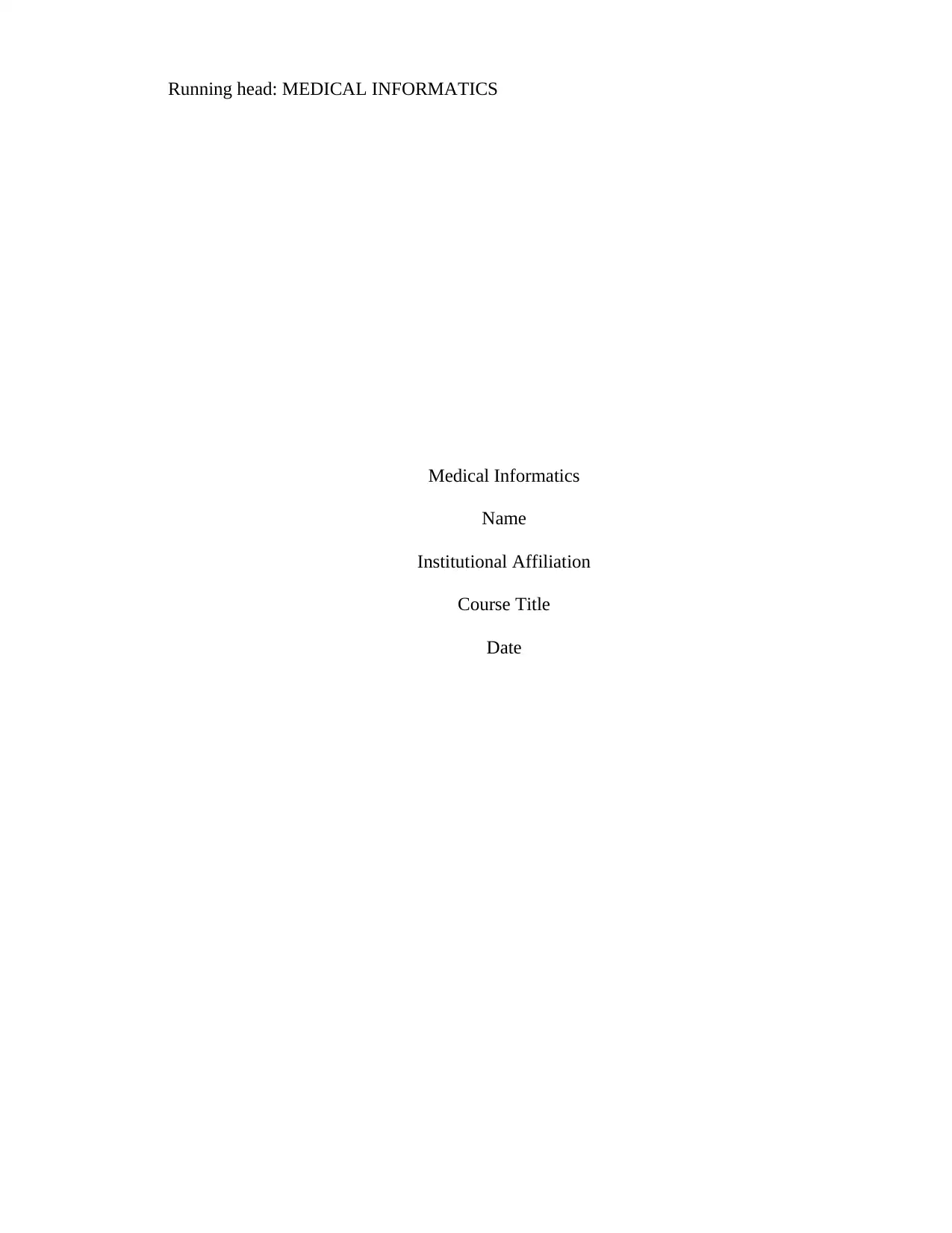
Running head: MEDICAL INFORMATICS
Medical Informatics
Name
Institutional Affiliation
Course Title
Date
Medical Informatics
Name
Institutional Affiliation
Course Title
Date
Paraphrase This Document
Need a fresh take? Get an instant paraphrase of this document with our AI Paraphraser

2
MEDICAL INFORMATICCS
Introduction
The speed with which a computer processes information makes it a vital tool in
information management. In all endeavors, the tool has transformed processes of handling
information and data, thus, it is the main information technology tool. Computer is known to
play critical roles in healthcare services transformation, as adjudged by consumers and
healthcare experts (Garlan et al., 2014).
In healthcare management, information technology deployment has been a game changer.
It has offered a mechanism that helps to improve reliability in the quality of healthcare. As
evidenced in this paper, medical literature as well as health information is being packaged and
efficiently delivered thanks to the vital role computer plays. With this powerful tool, we can
easily access the Internet, whose communication system is dynamic and far-reaching. On
virtually every field of endeavor therefore, the Internet influence is the most historic. In addition,
there has been an exponential increase in information sources therein.
Electronic Health Records
Most applications on healthcare communications and information technology require an
electronic capture of clinical information that is patient-specific. For the last half a decade, the
focus has been to create sustainable electronic health records (EHRs). As an essential technology
for healthcare, the Institute of Medicine (IOM) called for computer-based patient records
implementation across the nation. Throughout the healthcare system, their availability would be
instantaneous. Physicians and other health care providers can easily understand the forms in
which they are provided, even from a separate location. Nevertheless, since 1991 when the
vision was set, there has been a glacial progress rate toward its realization.
MEDICAL INFORMATICCS
Introduction
The speed with which a computer processes information makes it a vital tool in
information management. In all endeavors, the tool has transformed processes of handling
information and data, thus, it is the main information technology tool. Computer is known to
play critical roles in healthcare services transformation, as adjudged by consumers and
healthcare experts (Garlan et al., 2014).
In healthcare management, information technology deployment has been a game changer.
It has offered a mechanism that helps to improve reliability in the quality of healthcare. As
evidenced in this paper, medical literature as well as health information is being packaged and
efficiently delivered thanks to the vital role computer plays. With this powerful tool, we can
easily access the Internet, whose communication system is dynamic and far-reaching. On
virtually every field of endeavor therefore, the Internet influence is the most historic. In addition,
there has been an exponential increase in information sources therein.
Electronic Health Records
Most applications on healthcare communications and information technology require an
electronic capture of clinical information that is patient-specific. For the last half a decade, the
focus has been to create sustainable electronic health records (EHRs). As an essential technology
for healthcare, the Institute of Medicine (IOM) called for computer-based patient records
implementation across the nation. Throughout the healthcare system, their availability would be
instantaneous. Physicians and other health care providers can easily understand the forms in
which they are provided, even from a separate location. Nevertheless, since 1991 when the
vision was set, there has been a glacial progress rate toward its realization.
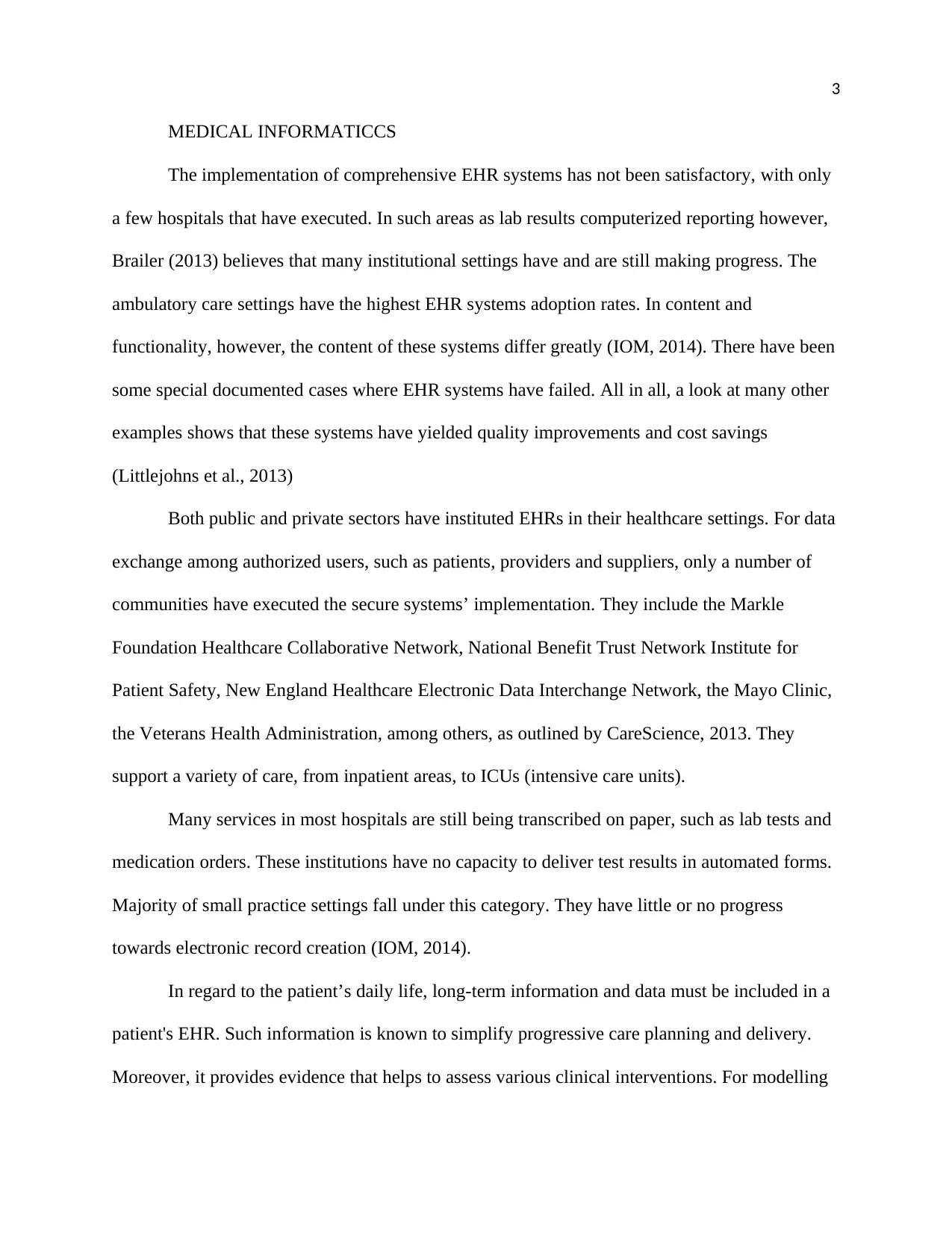
3
MEDICAL INFORMATICCS
The implementation of comprehensive EHR systems has not been satisfactory, with only
a few hospitals that have executed. In such areas as lab results computerized reporting however,
Brailer (2013) believes that many institutional settings have and are still making progress. The
ambulatory care settings have the highest EHR systems adoption rates. In content and
functionality, however, the content of these systems differ greatly (IOM, 2014). There have been
some special documented cases where EHR systems have failed. All in all, a look at many other
examples shows that these systems have yielded quality improvements and cost savings
(Littlejohns et al., 2013)
Both public and private sectors have instituted EHRs in their healthcare settings. For data
exchange among authorized users, such as patients, providers and suppliers, only a number of
communities have executed the secure systems’ implementation. They include the Markle
Foundation Healthcare Collaborative Network, National Benefit Trust Network Institute for
Patient Safety, New England Healthcare Electronic Data Interchange Network, the Mayo Clinic,
the Veterans Health Administration, among others, as outlined by CareScience, 2013. They
support a variety of care, from inpatient areas, to ICUs (intensive care units).
Many services in most hospitals are still being transcribed on paper, such as lab tests and
medication orders. These institutions have no capacity to deliver test results in automated forms.
Majority of small practice settings fall under this category. They have little or no progress
towards electronic record creation (IOM, 2014).
In regard to the patient’s daily life, long-term information and data must be included in a
patient's EHR. Such information is known to simplify progressive care planning and delivery.
Moreover, it provides evidence that helps to assess various clinical interventions. For modelling
MEDICAL INFORMATICCS
The implementation of comprehensive EHR systems has not been satisfactory, with only
a few hospitals that have executed. In such areas as lab results computerized reporting however,
Brailer (2013) believes that many institutional settings have and are still making progress. The
ambulatory care settings have the highest EHR systems adoption rates. In content and
functionality, however, the content of these systems differ greatly (IOM, 2014). There have been
some special documented cases where EHR systems have failed. All in all, a look at many other
examples shows that these systems have yielded quality improvements and cost savings
(Littlejohns et al., 2013)
Both public and private sectors have instituted EHRs in their healthcare settings. For data
exchange among authorized users, such as patients, providers and suppliers, only a number of
communities have executed the secure systems’ implementation. They include the Markle
Foundation Healthcare Collaborative Network, National Benefit Trust Network Institute for
Patient Safety, New England Healthcare Electronic Data Interchange Network, the Mayo Clinic,
the Veterans Health Administration, among others, as outlined by CareScience, 2013. They
support a variety of care, from inpatient areas, to ICUs (intensive care units).
Many services in most hospitals are still being transcribed on paper, such as lab tests and
medication orders. These institutions have no capacity to deliver test results in automated forms.
Majority of small practice settings fall under this category. They have little or no progress
towards electronic record creation (IOM, 2014).
In regard to the patient’s daily life, long-term information and data must be included in a
patient's EHR. Such information is known to simplify progressive care planning and delivery.
Moreover, it provides evidence that helps to assess various clinical interventions. For modelling
⊘ This is a preview!⊘
Do you want full access?
Subscribe today to unlock all pages.

Trusted by 1+ million students worldwide
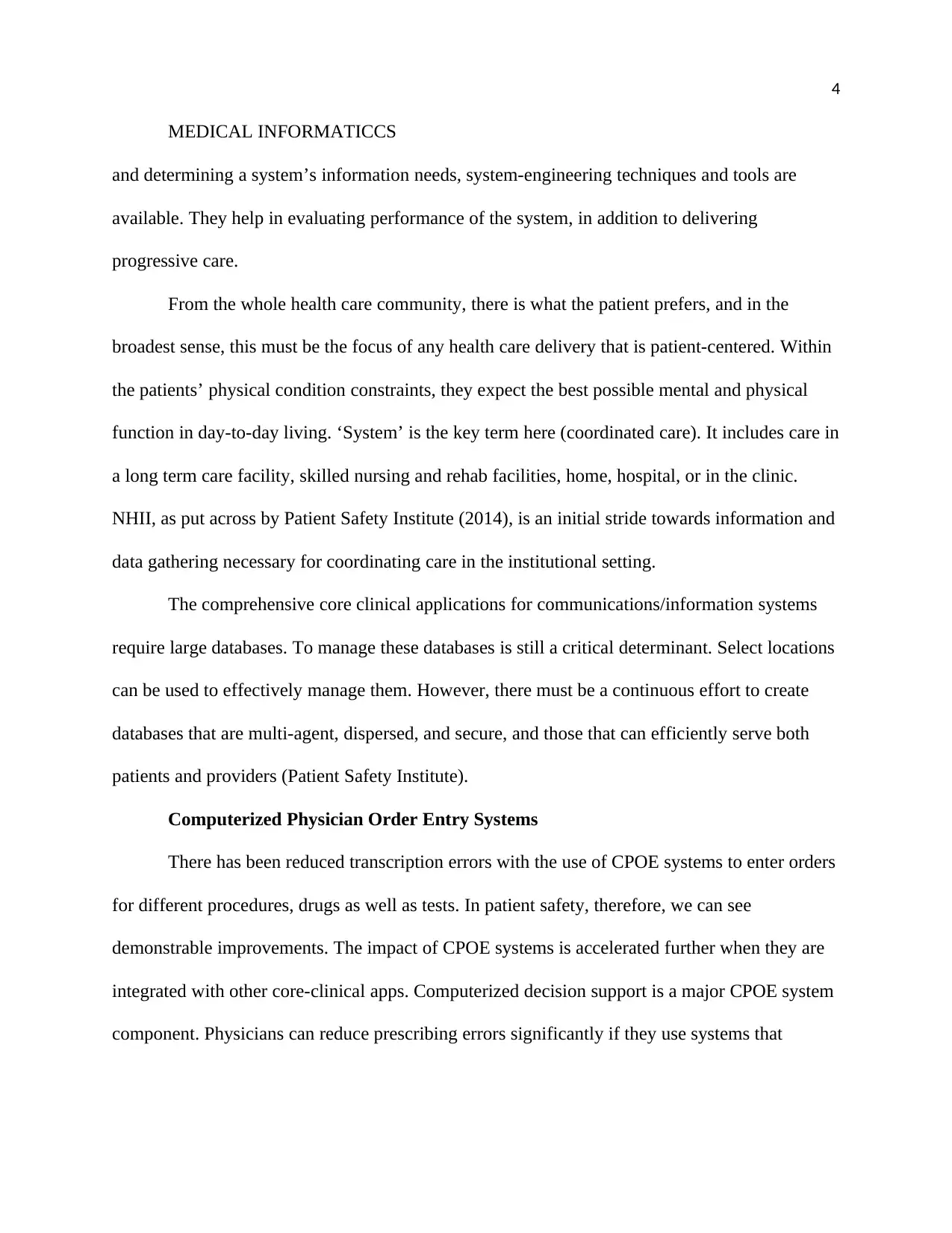
4
MEDICAL INFORMATICCS
and determining a system’s information needs, system-engineering techniques and tools are
available. They help in evaluating performance of the system, in addition to delivering
progressive care.
From the whole health care community, there is what the patient prefers, and in the
broadest sense, this must be the focus of any health care delivery that is patient-centered. Within
the patients’ physical condition constraints, they expect the best possible mental and physical
function in day-to-day living. ‘System’ is the key term here (coordinated care). It includes care in
a long term care facility, skilled nursing and rehab facilities, home, hospital, or in the clinic.
NHII, as put across by Patient Safety Institute (2014), is an initial stride towards information and
data gathering necessary for coordinating care in the institutional setting.
The comprehensive core clinical applications for communications/information systems
require large databases. To manage these databases is still a critical determinant. Select locations
can be used to effectively manage them. However, there must be a continuous effort to create
databases that are multi-agent, dispersed, and secure, and those that can efficiently serve both
patients and providers (Patient Safety Institute).
Computerized Physician Order Entry Systems
There has been reduced transcription errors with the use of CPOE systems to enter orders
for different procedures, drugs as well as tests. In patient safety, therefore, we can see
demonstrable improvements. The impact of CPOE systems is accelerated further when they are
integrated with other core-clinical apps. Computerized decision support is a major CPOE system
component. Physicians can reduce prescribing errors significantly if they use systems that
MEDICAL INFORMATICCS
and determining a system’s information needs, system-engineering techniques and tools are
available. They help in evaluating performance of the system, in addition to delivering
progressive care.
From the whole health care community, there is what the patient prefers, and in the
broadest sense, this must be the focus of any health care delivery that is patient-centered. Within
the patients’ physical condition constraints, they expect the best possible mental and physical
function in day-to-day living. ‘System’ is the key term here (coordinated care). It includes care in
a long term care facility, skilled nursing and rehab facilities, home, hospital, or in the clinic.
NHII, as put across by Patient Safety Institute (2014), is an initial stride towards information and
data gathering necessary for coordinating care in the institutional setting.
The comprehensive core clinical applications for communications/information systems
require large databases. To manage these databases is still a critical determinant. Select locations
can be used to effectively manage them. However, there must be a continuous effort to create
databases that are multi-agent, dispersed, and secure, and those that can efficiently serve both
patients and providers (Patient Safety Institute).
Computerized Physician Order Entry Systems
There has been reduced transcription errors with the use of CPOE systems to enter orders
for different procedures, drugs as well as tests. In patient safety, therefore, we can see
demonstrable improvements. The impact of CPOE systems is accelerated further when they are
integrated with other core-clinical apps. Computerized decision support is a major CPOE system
component. Physicians can reduce prescribing errors significantly if they use systems that
Paraphrase This Document
Need a fresh take? Get an instant paraphrase of this document with our AI Paraphraser
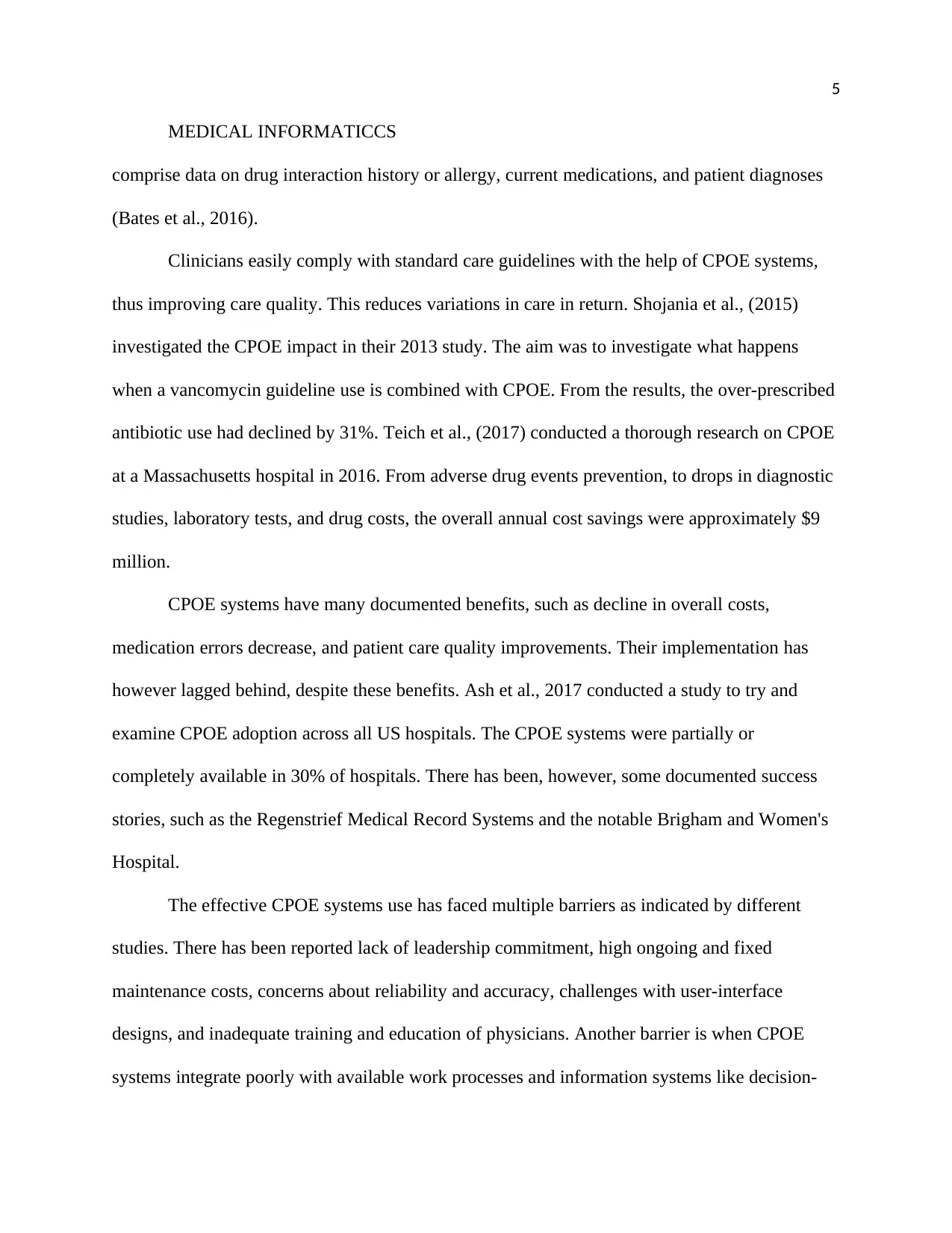
5
MEDICAL INFORMATICCS
comprise data on drug interaction history or allergy, current medications, and patient diagnoses
(Bates et al., 2016).
Clinicians easily comply with standard care guidelines with the help of CPOE systems,
thus improving care quality. This reduces variations in care in return. Shojania et al., (2015)
investigated the CPOE impact in their 2013 study. The aim was to investigate what happens
when a vancomycin guideline use is combined with CPOE. From the results, the over-prescribed
antibiotic use had declined by 31%. Teich et al., (2017) conducted a thorough research on CPOE
at a Massachusetts hospital in 2016. From adverse drug events prevention, to drops in diagnostic
studies, laboratory tests, and drug costs, the overall annual cost savings were approximately $9
million.
CPOE systems have many documented benefits, such as decline in overall costs,
medication errors decrease, and patient care quality improvements. Their implementation has
however lagged behind, despite these benefits. Ash et al., 2017 conducted a study to try and
examine CPOE adoption across all US hospitals. The CPOE systems were partially or
completely available in 30% of hospitals. There has been, however, some documented success
stories, such as the Regenstrief Medical Record Systems and the notable Brigham and Women's
Hospital.
The effective CPOE systems use has faced multiple barriers as indicated by different
studies. There has been reported lack of leadership commitment, high ongoing and fixed
maintenance costs, concerns about reliability and accuracy, challenges with user-interface
designs, and inadequate training and education of physicians. Another barrier is when CPOE
systems integrate poorly with available work processes and information systems like decision-
MEDICAL INFORMATICCS
comprise data on drug interaction history or allergy, current medications, and patient diagnoses
(Bates et al., 2016).
Clinicians easily comply with standard care guidelines with the help of CPOE systems,
thus improving care quality. This reduces variations in care in return. Shojania et al., (2015)
investigated the CPOE impact in their 2013 study. The aim was to investigate what happens
when a vancomycin guideline use is combined with CPOE. From the results, the over-prescribed
antibiotic use had declined by 31%. Teich et al., (2017) conducted a thorough research on CPOE
at a Massachusetts hospital in 2016. From adverse drug events prevention, to drops in diagnostic
studies, laboratory tests, and drug costs, the overall annual cost savings were approximately $9
million.
CPOE systems have many documented benefits, such as decline in overall costs,
medication errors decrease, and patient care quality improvements. Their implementation has
however lagged behind, despite these benefits. Ash et al., 2017 conducted a study to try and
examine CPOE adoption across all US hospitals. The CPOE systems were partially or
completely available in 30% of hospitals. There has been, however, some documented success
stories, such as the Regenstrief Medical Record Systems and the notable Brigham and Women's
Hospital.
The effective CPOE systems use has faced multiple barriers as indicated by different
studies. There has been reported lack of leadership commitment, high ongoing and fixed
maintenance costs, concerns about reliability and accuracy, challenges with user-interface
designs, and inadequate training and education of physicians. Another barrier is when CPOE
systems integrate poorly with available work processes and information systems like decision-
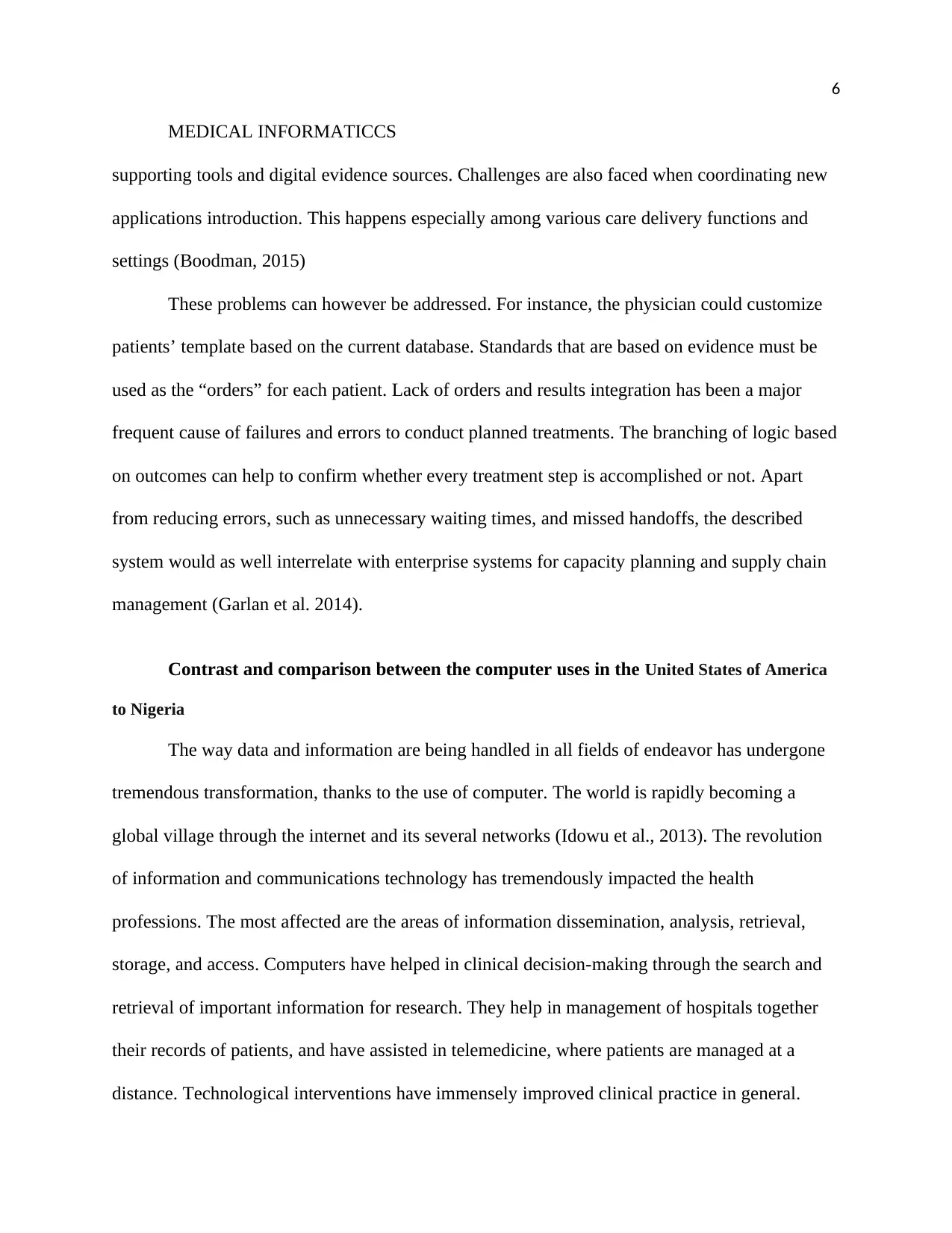
6
MEDICAL INFORMATICCS
supporting tools and digital evidence sources. Challenges are also faced when coordinating new
applications introduction. This happens especially among various care delivery functions and
settings (Boodman, 2015)
These problems can however be addressed. For instance, the physician could customize
patients’ template based on the current database. Standards that are based on evidence must be
used as the “orders” for each patient. Lack of orders and results integration has been a major
frequent cause of failures and errors to conduct planned treatments. The branching of logic based
on outcomes can help to confirm whether every treatment step is accomplished or not. Apart
from reducing errors, such as unnecessary waiting times, and missed handoffs, the described
system would as well interrelate with enterprise systems for capacity planning and supply chain
management (Garlan et al. 2014).
Contrast and comparison between the computer uses in the United States of America
to Nigeria
The way data and information are being handled in all fields of endeavor has undergone
tremendous transformation, thanks to the use of computer. The world is rapidly becoming a
global village through the internet and its several networks (Idowu et al., 2013). The revolution
of information and communications technology has tremendously impacted the health
professions. The most affected are the areas of information dissemination, analysis, retrieval,
storage, and access. Computers have helped in clinical decision-making through the search and
retrieval of important information for research. They help in management of hospitals together
their records of patients, and have assisted in telemedicine, where patients are managed at a
distance. Technological interventions have immensely improved clinical practice in general.
MEDICAL INFORMATICCS
supporting tools and digital evidence sources. Challenges are also faced when coordinating new
applications introduction. This happens especially among various care delivery functions and
settings (Boodman, 2015)
These problems can however be addressed. For instance, the physician could customize
patients’ template based on the current database. Standards that are based on evidence must be
used as the “orders” for each patient. Lack of orders and results integration has been a major
frequent cause of failures and errors to conduct planned treatments. The branching of logic based
on outcomes can help to confirm whether every treatment step is accomplished or not. Apart
from reducing errors, such as unnecessary waiting times, and missed handoffs, the described
system would as well interrelate with enterprise systems for capacity planning and supply chain
management (Garlan et al. 2014).
Contrast and comparison between the computer uses in the United States of America
to Nigeria
The way data and information are being handled in all fields of endeavor has undergone
tremendous transformation, thanks to the use of computer. The world is rapidly becoming a
global village through the internet and its several networks (Idowu et al., 2013). The revolution
of information and communications technology has tremendously impacted the health
professions. The most affected are the areas of information dissemination, analysis, retrieval,
storage, and access. Computers have helped in clinical decision-making through the search and
retrieval of important information for research. They help in management of hospitals together
their records of patients, and have assisted in telemedicine, where patients are managed at a
distance. Technological interventions have immensely improved clinical practice in general.
⊘ This is a preview!⊘
Do you want full access?
Subscribe today to unlock all pages.

Trusted by 1+ million students worldwide
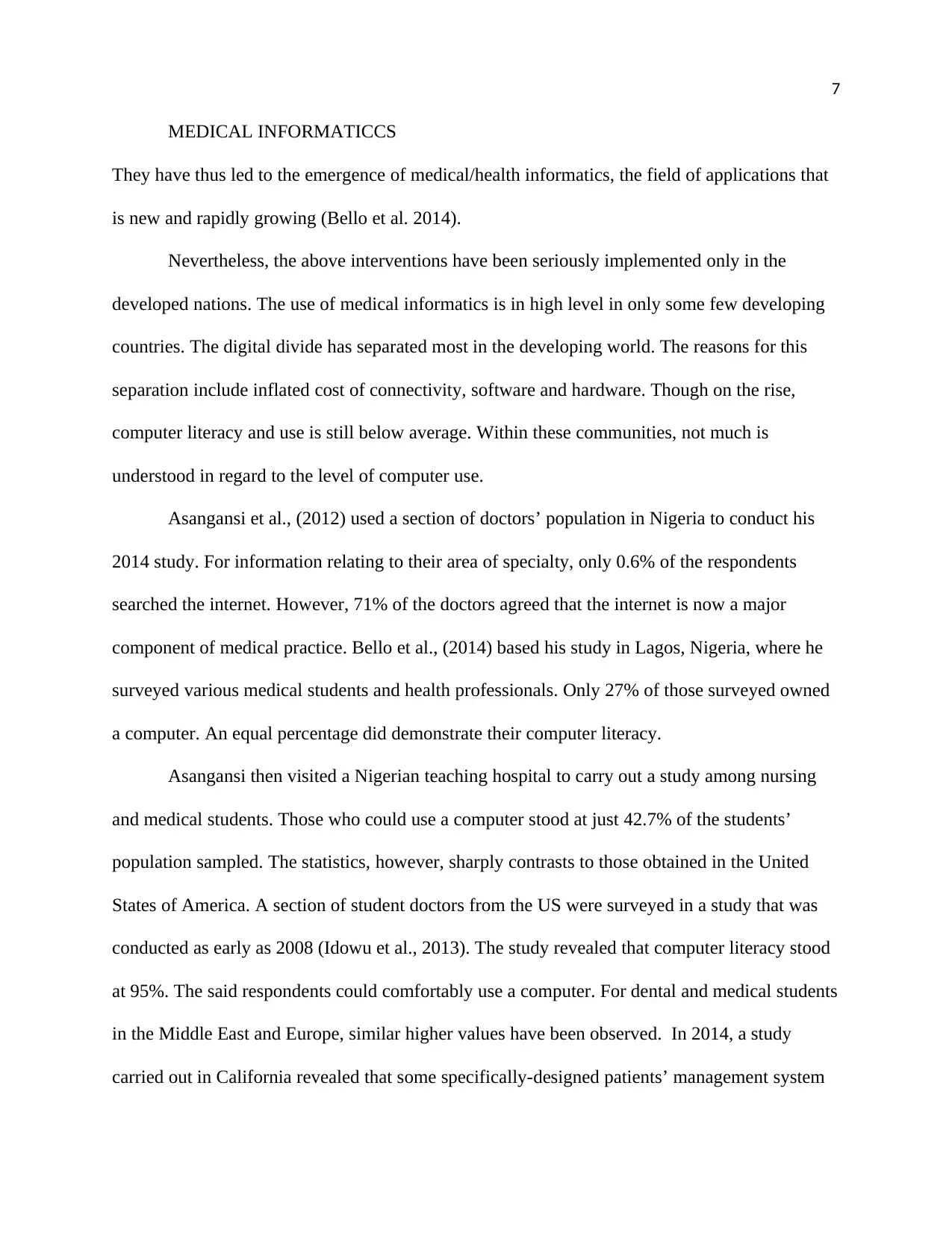
7
MEDICAL INFORMATICCS
They have thus led to the emergence of medical/health informatics, the field of applications that
is new and rapidly growing (Bello et al. 2014).
Nevertheless, the above interventions have been seriously implemented only in the
developed nations. The use of medical informatics is in high level in only some few developing
countries. The digital divide has separated most in the developing world. The reasons for this
separation include inflated cost of connectivity, software and hardware. Though on the rise,
computer literacy and use is still below average. Within these communities, not much is
understood in regard to the level of computer use.
Asangansi et al., (2012) used a section of doctors’ population in Nigeria to conduct his
2014 study. For information relating to their area of specialty, only 0.6% of the respondents
searched the internet. However, 71% of the doctors agreed that the internet is now a major
component of medical practice. Bello et al., (2014) based his study in Lagos, Nigeria, where he
surveyed various medical students and health professionals. Only 27% of those surveyed owned
a computer. An equal percentage did demonstrate their computer literacy.
Asangansi then visited a Nigerian teaching hospital to carry out a study among nursing
and medical students. Those who could use a computer stood at just 42.7% of the students’
population sampled. The statistics, however, sharply contrasts to those obtained in the United
States of America. A section of student doctors from the US were surveyed in a study that was
conducted as early as 2008 (Idowu et al., 2013). The study revealed that computer literacy stood
at 95%. The said respondents could comfortably use a computer. For dental and medical students
in the Middle East and Europe, similar higher values have been observed. In 2014, a study
carried out in California revealed that some specifically-designed patients’ management system
MEDICAL INFORMATICCS
They have thus led to the emergence of medical/health informatics, the field of applications that
is new and rapidly growing (Bello et al. 2014).
Nevertheless, the above interventions have been seriously implemented only in the
developed nations. The use of medical informatics is in high level in only some few developing
countries. The digital divide has separated most in the developing world. The reasons for this
separation include inflated cost of connectivity, software and hardware. Though on the rise,
computer literacy and use is still below average. Within these communities, not much is
understood in regard to the level of computer use.
Asangansi et al., (2012) used a section of doctors’ population in Nigeria to conduct his
2014 study. For information relating to their area of specialty, only 0.6% of the respondents
searched the internet. However, 71% of the doctors agreed that the internet is now a major
component of medical practice. Bello et al., (2014) based his study in Lagos, Nigeria, where he
surveyed various medical students and health professionals. Only 27% of those surveyed owned
a computer. An equal percentage did demonstrate their computer literacy.
Asangansi then visited a Nigerian teaching hospital to carry out a study among nursing
and medical students. Those who could use a computer stood at just 42.7% of the students’
population sampled. The statistics, however, sharply contrasts to those obtained in the United
States of America. A section of student doctors from the US were surveyed in a study that was
conducted as early as 2008 (Idowu et al., 2013). The study revealed that computer literacy stood
at 95%. The said respondents could comfortably use a computer. For dental and medical students
in the Middle East and Europe, similar higher values have been observed. In 2014, a study
carried out in California revealed that some specifically-designed patients’ management system
Paraphrase This Document
Need a fresh take? Get an instant paraphrase of this document with our AI Paraphraser
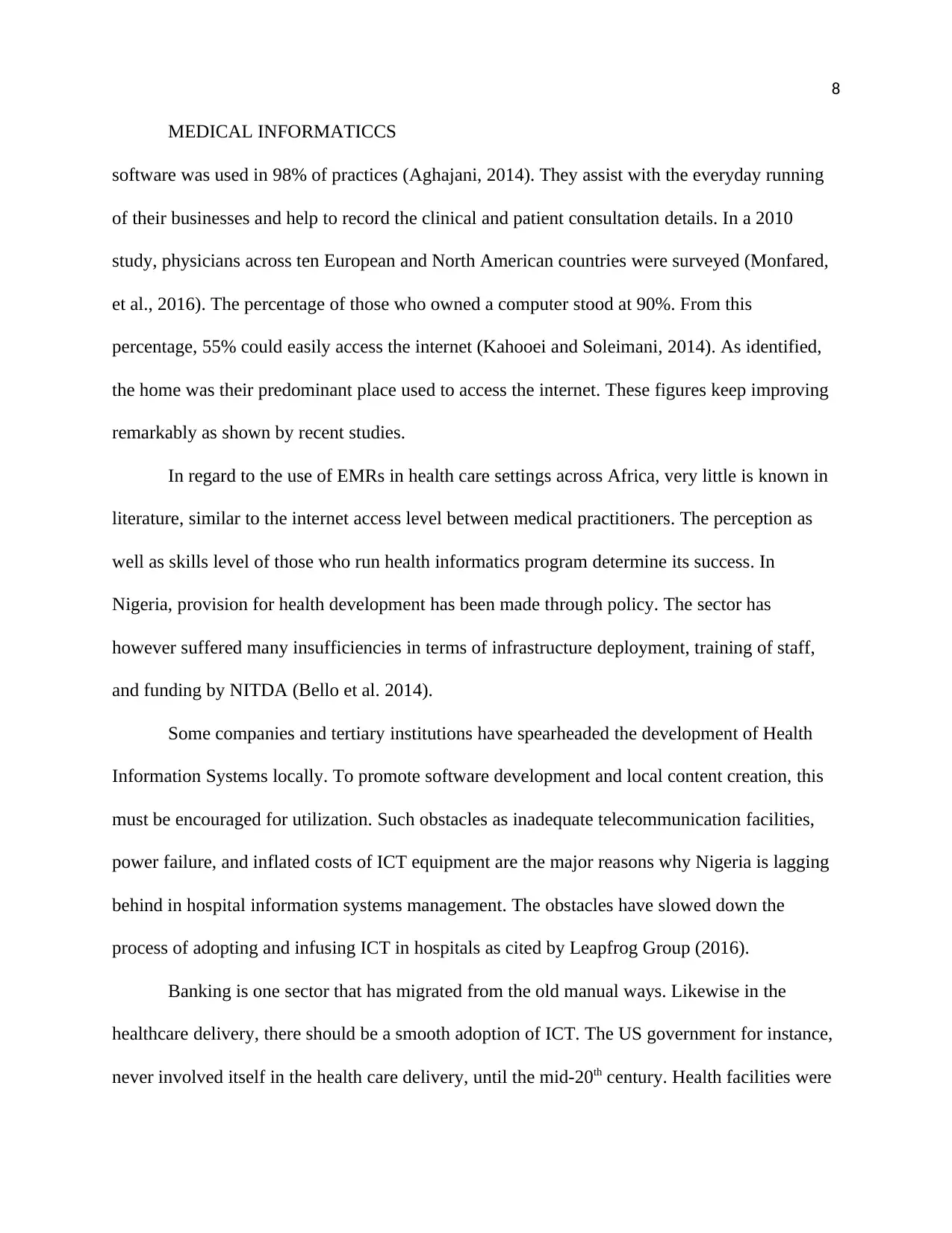
8
MEDICAL INFORMATICCS
software was used in 98% of practices (Aghajani, 2014). They assist with the everyday running
of their businesses and help to record the clinical and patient consultation details. In a 2010
study, physicians across ten European and North American countries were surveyed (Monfared,
et al., 2016). The percentage of those who owned a computer stood at 90%. From this
percentage, 55% could easily access the internet (Kahooei and Soleimani, 2014). As identified,
the home was their predominant place used to access the internet. These figures keep improving
remarkably as shown by recent studies.
In regard to the use of EMRs in health care settings across Africa, very little is known in
literature, similar to the internet access level between medical practitioners. The perception as
well as skills level of those who run health informatics program determine its success. In
Nigeria, provision for health development has been made through policy. The sector has
however suffered many insufficiencies in terms of infrastructure deployment, training of staff,
and funding by NITDA (Bello et al. 2014).
Some companies and tertiary institutions have spearheaded the development of Health
Information Systems locally. To promote software development and local content creation, this
must be encouraged for utilization. Such obstacles as inadequate telecommunication facilities,
power failure, and inflated costs of ICT equipment are the major reasons why Nigeria is lagging
behind in hospital information systems management. The obstacles have slowed down the
process of adopting and infusing ICT in hospitals as cited by Leapfrog Group (2016).
Banking is one sector that has migrated from the old manual ways. Likewise in the
healthcare delivery, there should be a smooth adoption of ICT. The US government for instance,
never involved itself in the health care delivery, until the mid-20th century. Health facilities were
MEDICAL INFORMATICCS
software was used in 98% of practices (Aghajani, 2014). They assist with the everyday running
of their businesses and help to record the clinical and patient consultation details. In a 2010
study, physicians across ten European and North American countries were surveyed (Monfared,
et al., 2016). The percentage of those who owned a computer stood at 90%. From this
percentage, 55% could easily access the internet (Kahooei and Soleimani, 2014). As identified,
the home was their predominant place used to access the internet. These figures keep improving
remarkably as shown by recent studies.
In regard to the use of EMRs in health care settings across Africa, very little is known in
literature, similar to the internet access level between medical practitioners. The perception as
well as skills level of those who run health informatics program determine its success. In
Nigeria, provision for health development has been made through policy. The sector has
however suffered many insufficiencies in terms of infrastructure deployment, training of staff,
and funding by NITDA (Bello et al. 2014).
Some companies and tertiary institutions have spearheaded the development of Health
Information Systems locally. To promote software development and local content creation, this
must be encouraged for utilization. Such obstacles as inadequate telecommunication facilities,
power failure, and inflated costs of ICT equipment are the major reasons why Nigeria is lagging
behind in hospital information systems management. The obstacles have slowed down the
process of adopting and infusing ICT in hospitals as cited by Leapfrog Group (2016).
Banking is one sector that has migrated from the old manual ways. Likewise in the
healthcare delivery, there should be a smooth adoption of ICT. The US government for instance,
never involved itself in the health care delivery, until the mid-20th century. Health facilities were
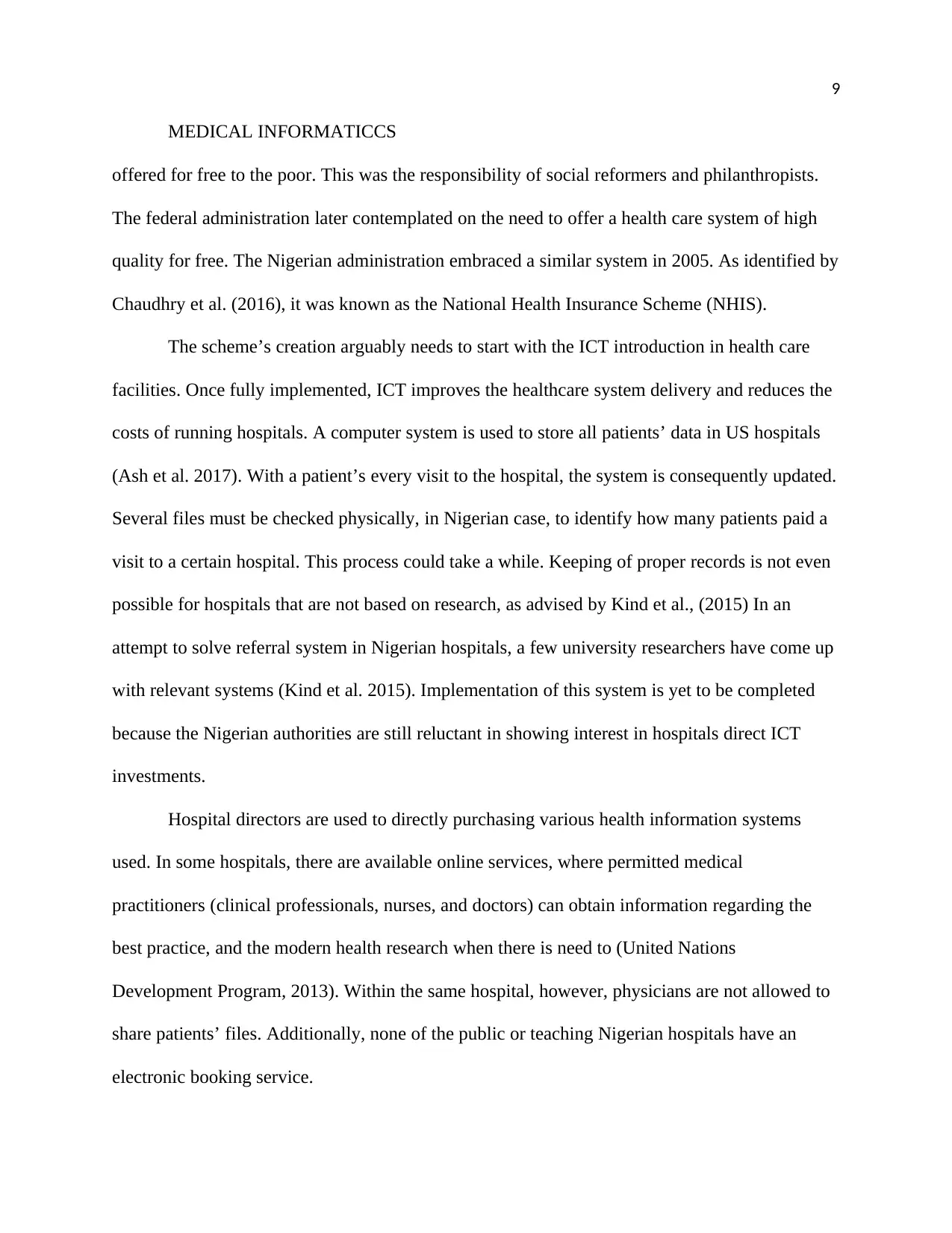
9
MEDICAL INFORMATICCS
offered for free to the poor. This was the responsibility of social reformers and philanthropists.
The federal administration later contemplated on the need to offer a health care system of high
quality for free. The Nigerian administration embraced a similar system in 2005. As identified by
Chaudhry et al. (2016), it was known as the National Health Insurance Scheme (NHIS).
The scheme’s creation arguably needs to start with the ICT introduction in health care
facilities. Once fully implemented, ICT improves the healthcare system delivery and reduces the
costs of running hospitals. A computer system is used to store all patients’ data in US hospitals
(Ash et al. 2017). With a patient’s every visit to the hospital, the system is consequently updated.
Several files must be checked physically, in Nigerian case, to identify how many patients paid a
visit to a certain hospital. This process could take a while. Keeping of proper records is not even
possible for hospitals that are not based on research, as advised by Kind et al., (2015) In an
attempt to solve referral system in Nigerian hospitals, a few university researchers have come up
with relevant systems (Kind et al. 2015). Implementation of this system is yet to be completed
because the Nigerian authorities are still reluctant in showing interest in hospitals direct ICT
investments.
Hospital directors are used to directly purchasing various health information systems
used. In some hospitals, there are available online services, where permitted medical
practitioners (clinical professionals, nurses, and doctors) can obtain information regarding the
best practice, and the modern health research when there is need to (United Nations
Development Program, 2013). Within the same hospital, however, physicians are not allowed to
share patients’ files. Additionally, none of the public or teaching Nigerian hospitals have an
electronic booking service.
MEDICAL INFORMATICCS
offered for free to the poor. This was the responsibility of social reformers and philanthropists.
The federal administration later contemplated on the need to offer a health care system of high
quality for free. The Nigerian administration embraced a similar system in 2005. As identified by
Chaudhry et al. (2016), it was known as the National Health Insurance Scheme (NHIS).
The scheme’s creation arguably needs to start with the ICT introduction in health care
facilities. Once fully implemented, ICT improves the healthcare system delivery and reduces the
costs of running hospitals. A computer system is used to store all patients’ data in US hospitals
(Ash et al. 2017). With a patient’s every visit to the hospital, the system is consequently updated.
Several files must be checked physically, in Nigerian case, to identify how many patients paid a
visit to a certain hospital. This process could take a while. Keeping of proper records is not even
possible for hospitals that are not based on research, as advised by Kind et al., (2015) In an
attempt to solve referral system in Nigerian hospitals, a few university researchers have come up
with relevant systems (Kind et al. 2015). Implementation of this system is yet to be completed
because the Nigerian authorities are still reluctant in showing interest in hospitals direct ICT
investments.
Hospital directors are used to directly purchasing various health information systems
used. In some hospitals, there are available online services, where permitted medical
practitioners (clinical professionals, nurses, and doctors) can obtain information regarding the
best practice, and the modern health research when there is need to (United Nations
Development Program, 2013). Within the same hospital, however, physicians are not allowed to
share patients’ files. Additionally, none of the public or teaching Nigerian hospitals have an
electronic booking service.
⊘ This is a preview!⊘
Do you want full access?
Subscribe today to unlock all pages.

Trusted by 1+ million students worldwide
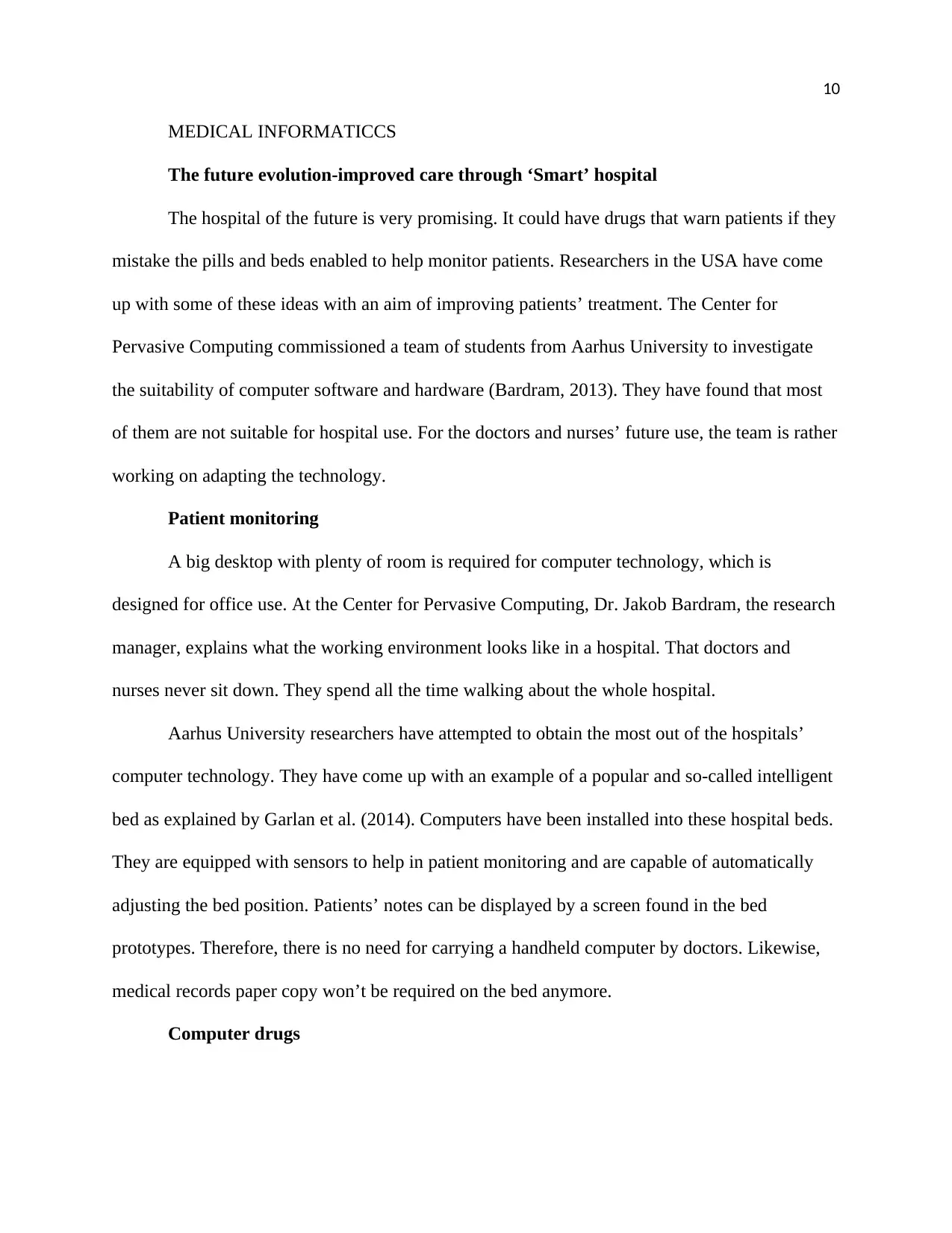
10
MEDICAL INFORMATICCS
The future evolution-improved care through ‘Smart’ hospital
The hospital of the future is very promising. It could have drugs that warn patients if they
mistake the pills and beds enabled to help monitor patients. Researchers in the USA have come
up with some of these ideas with an aim of improving patients’ treatment. The Center for
Pervasive Computing commissioned a team of students from Aarhus University to investigate
the suitability of computer software and hardware (Bardram, 2013). They have found that most
of them are not suitable for hospital use. For the doctors and nurses’ future use, the team is rather
working on adapting the technology.
Patient monitoring
A big desktop with plenty of room is required for computer technology, which is
designed for office use. At the Center for Pervasive Computing, Dr. Jakob Bardram, the research
manager, explains what the working environment looks like in a hospital. That doctors and
nurses never sit down. They spend all the time walking about the whole hospital.
Aarhus University researchers have attempted to obtain the most out of the hospitals’
computer technology. They have come up with an example of a popular and so-called intelligent
bed as explained by Garlan et al. (2014). Computers have been installed into these hospital beds.
They are equipped with sensors to help in patient monitoring and are capable of automatically
adjusting the bed position. Patients’ notes can be displayed by a screen found in the bed
prototypes. Therefore, there is no need for carrying a handheld computer by doctors. Likewise,
medical records paper copy won’t be required on the bed anymore.
Computer drugs
MEDICAL INFORMATICCS
The future evolution-improved care through ‘Smart’ hospital
The hospital of the future is very promising. It could have drugs that warn patients if they
mistake the pills and beds enabled to help monitor patients. Researchers in the USA have come
up with some of these ideas with an aim of improving patients’ treatment. The Center for
Pervasive Computing commissioned a team of students from Aarhus University to investigate
the suitability of computer software and hardware (Bardram, 2013). They have found that most
of them are not suitable for hospital use. For the doctors and nurses’ future use, the team is rather
working on adapting the technology.
Patient monitoring
A big desktop with plenty of room is required for computer technology, which is
designed for office use. At the Center for Pervasive Computing, Dr. Jakob Bardram, the research
manager, explains what the working environment looks like in a hospital. That doctors and
nurses never sit down. They spend all the time walking about the whole hospital.
Aarhus University researchers have attempted to obtain the most out of the hospitals’
computer technology. They have come up with an example of a popular and so-called intelligent
bed as explained by Garlan et al. (2014). Computers have been installed into these hospital beds.
They are equipped with sensors to help in patient monitoring and are capable of automatically
adjusting the bed position. Patients’ notes can be displayed by a screen found in the bed
prototypes. Therefore, there is no need for carrying a handheld computer by doctors. Likewise,
medical records paper copy won’t be required on the bed anymore.
Computer drugs
Paraphrase This Document
Need a fresh take? Get an instant paraphrase of this document with our AI Paraphraser
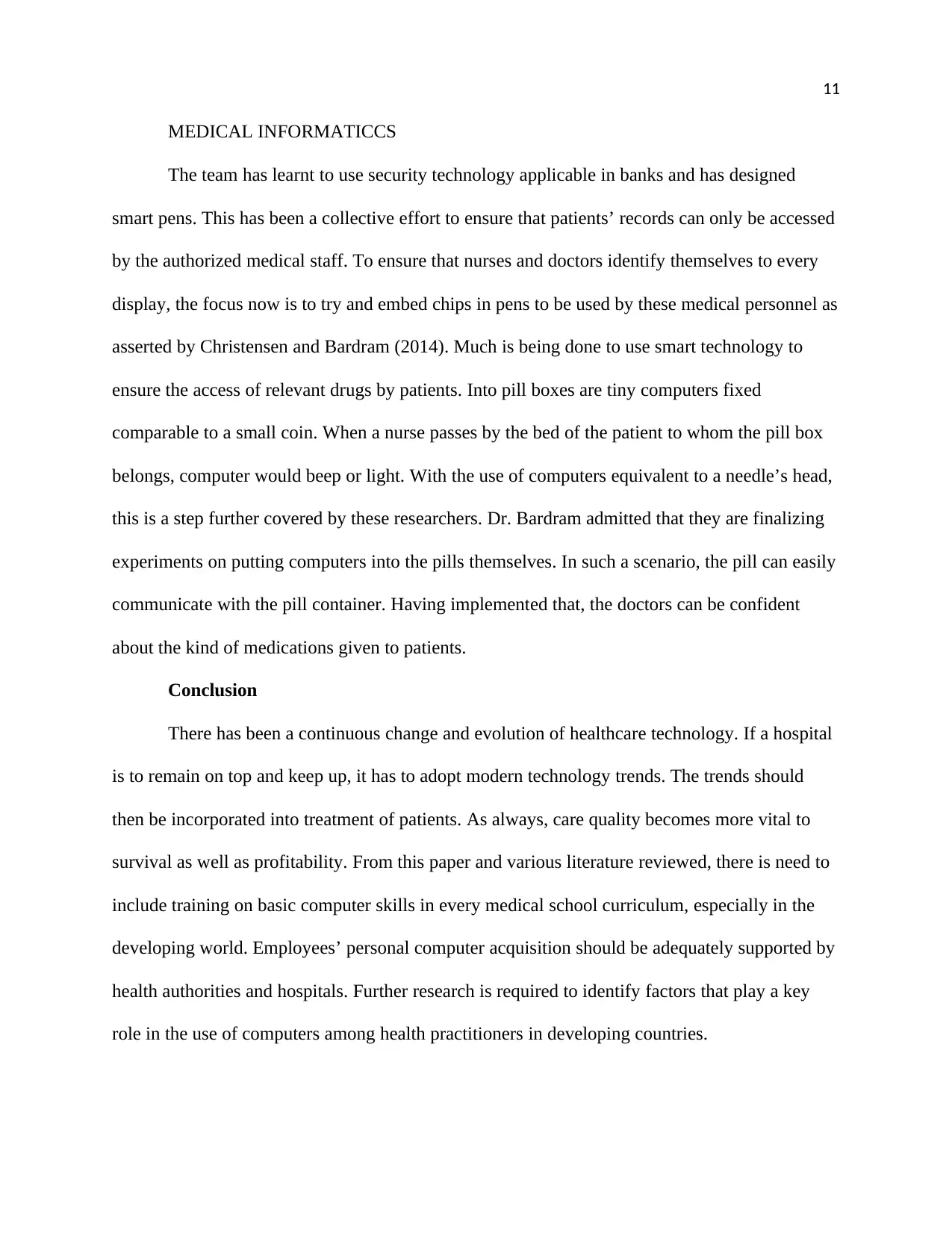
11
MEDICAL INFORMATICCS
The team has learnt to use security technology applicable in banks and has designed
smart pens. This has been a collective effort to ensure that patients’ records can only be accessed
by the authorized medical staff. To ensure that nurses and doctors identify themselves to every
display, the focus now is to try and embed chips in pens to be used by these medical personnel as
asserted by Christensen and Bardram (2014). Much is being done to use smart technology to
ensure the access of relevant drugs by patients. Into pill boxes are tiny computers fixed
comparable to a small coin. When a nurse passes by the bed of the patient to whom the pill box
belongs, computer would beep or light. With the use of computers equivalent to a needle’s head,
this is a step further covered by these researchers. Dr. Bardram admitted that they are finalizing
experiments on putting computers into the pills themselves. In such a scenario, the pill can easily
communicate with the pill container. Having implemented that, the doctors can be confident
about the kind of medications given to patients.
Conclusion
There has been a continuous change and evolution of healthcare technology. If a hospital
is to remain on top and keep up, it has to adopt modern technology trends. The trends should
then be incorporated into treatment of patients. As always, care quality becomes more vital to
survival as well as profitability. From this paper and various literature reviewed, there is need to
include training on basic computer skills in every medical school curriculum, especially in the
developing world. Employees’ personal computer acquisition should be adequately supported by
health authorities and hospitals. Further research is required to identify factors that play a key
role in the use of computers among health practitioners in developing countries.
MEDICAL INFORMATICCS
The team has learnt to use security technology applicable in banks and has designed
smart pens. This has been a collective effort to ensure that patients’ records can only be accessed
by the authorized medical staff. To ensure that nurses and doctors identify themselves to every
display, the focus now is to try and embed chips in pens to be used by these medical personnel as
asserted by Christensen and Bardram (2014). Much is being done to use smart technology to
ensure the access of relevant drugs by patients. Into pill boxes are tiny computers fixed
comparable to a small coin. When a nurse passes by the bed of the patient to whom the pill box
belongs, computer would beep or light. With the use of computers equivalent to a needle’s head,
this is a step further covered by these researchers. Dr. Bardram admitted that they are finalizing
experiments on putting computers into the pills themselves. In such a scenario, the pill can easily
communicate with the pill container. Having implemented that, the doctors can be confident
about the kind of medications given to patients.
Conclusion
There has been a continuous change and evolution of healthcare technology. If a hospital
is to remain on top and keep up, it has to adopt modern technology trends. The trends should
then be incorporated into treatment of patients. As always, care quality becomes more vital to
survival as well as profitability. From this paper and various literature reviewed, there is need to
include training on basic computer skills in every medical school curriculum, especially in the
developing world. Employees’ personal computer acquisition should be adequately supported by
health authorities and hospitals. Further research is required to identify factors that play a key
role in the use of computers among health practitioners in developing countries.
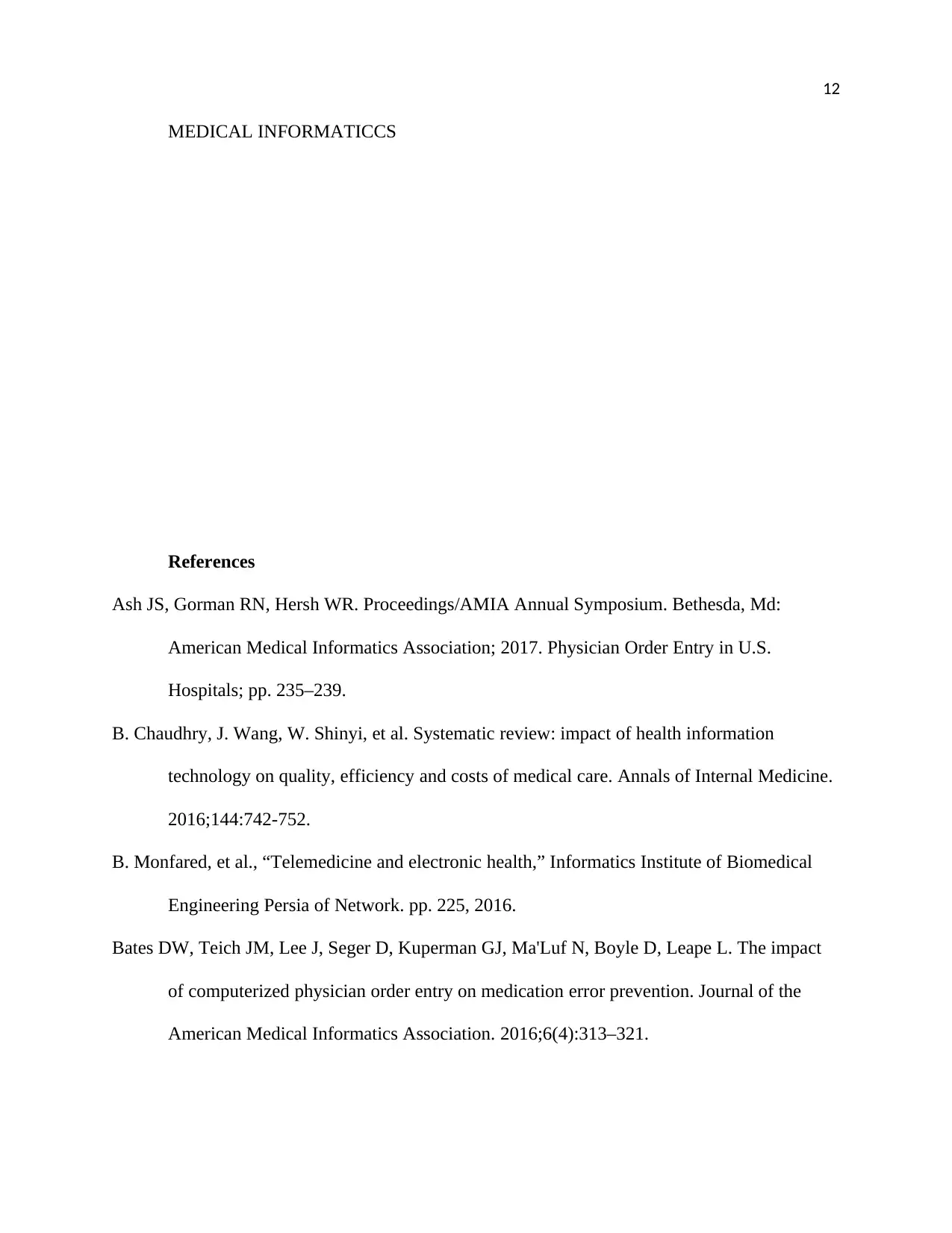
12
MEDICAL INFORMATICCS
References
Ash JS, Gorman RN, Hersh WR. Proceedings/AMIA Annual Symposium. Bethesda, Md:
American Medical Informatics Association; 2017. Physician Order Entry in U.S.
Hospitals; pp. 235–239.
B. Chaudhry, J. Wang, W. Shinyi, et al. Systematic review: impact of health information
technology on quality, efficiency and costs of medical care. Annals of Internal Medicine.
2016;144:742-752.
B. Monfared, et al., “Telemedicine and electronic health,” Informatics Institute of Biomedical
Engineering Persia of Network. pp. 225, 2016.
Bates DW, Teich JM, Lee J, Seger D, Kuperman GJ, Ma'Luf N, Boyle D, Leape L. The impact
of computerized physician order entry on medication error prevention. Journal of the
American Medical Informatics Association. 2016;6(4):313–321.
MEDICAL INFORMATICCS
References
Ash JS, Gorman RN, Hersh WR. Proceedings/AMIA Annual Symposium. Bethesda, Md:
American Medical Informatics Association; 2017. Physician Order Entry in U.S.
Hospitals; pp. 235–239.
B. Chaudhry, J. Wang, W. Shinyi, et al. Systematic review: impact of health information
technology on quality, efficiency and costs of medical care. Annals of Internal Medicine.
2016;144:742-752.
B. Monfared, et al., “Telemedicine and electronic health,” Informatics Institute of Biomedical
Engineering Persia of Network. pp. 225, 2016.
Bates DW, Teich JM, Lee J, Seger D, Kuperman GJ, Ma'Luf N, Boyle D, Leape L. The impact
of computerized physician order entry on medication error prevention. Journal of the
American Medical Informatics Association. 2016;6(4):313–321.
⊘ This is a preview!⊘
Do you want full access?
Subscribe today to unlock all pages.

Trusted by 1+ million students worldwide
1 out of 14
Related Documents
Your All-in-One AI-Powered Toolkit for Academic Success.
+13062052269
info@desklib.com
Available 24*7 on WhatsApp / Email
![[object Object]](/_next/static/media/star-bottom.7253800d.svg)
Unlock your academic potential
Copyright © 2020–2025 A2Z Services. All Rights Reserved. Developed and managed by ZUCOL.





